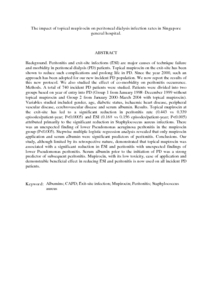Citation
Lim, Christopher Thiam Seong and Wong, Kok Seng and Foo, Marjorie Wai Yin
(2005)
The impact of topical mupirocin on peritoneal dialysis infection rates in Singapore general hospital.
Nephrology Dialysis Transplantation, 20 (8).
pp. 1702-1706.
ISSN 0931-0509, ESSN: 1460-2385
Abstract
Background.
Peritonitis and exit-site infections (ESI) are major causes of technique failure and morbidity in peritoneal dialysis (PD) patients. Topical mupirocin on the exit-site has been shown to reduce such complications and prolong life in PD. Since the year 2000, such an approach has been adopted for our new incident PD population. We now report the results of this new protocol. We also studied the effect of co-morbidity on peritonitis occurrence.
Methods.
A total of 740 incident PD patients were studied. Patients were divided into two groups based on year of entry into PD (Group 1 from January 1998–December 1999 without topical mupirocin and Group 2 from January 2000–March 2004 with topical mupirocin). Variables studied included gender, age, diabetic status, ischaemic heart disease, peripheral vascular disease, cerebrovascular disease and serum albumin.
Results.
Topical mupirocin at the exit-site has led to a significant reduction in peritonitis rate (0.443 vs 0.339 episodes/patient-year; P<0.0005) and ESI (0.168 vs 0.156 episodes/patient-year; P<0.005) attributed primarily to the significant reduction in Staphylococcus aureus infections. There was an unexpected finding of lower Pseudomonas aeruginosa peritonitis in the mupirocin group (P<0.005). Stepwise multiple logistic regression analysis revealed that only mupirocin application and serum albumin were significant predictors of peritonitis.
Conclusions.
Our study, although limited by its retrospective nature, demonstrated that topical mupirocin was associated with a significant reduction in ESI and peritonitis with unexpected findings of lower Pseudomonas peritonitis. Serum albumin prior to the initiation of PD was a strong predictor of subsequent peritonitis. Mupirocin, with its low toxicity, ease of application and demonstrable beneficial effect in reducing ESI and peritonitis is now used on all incident PD patients.
Download File
![[img]](http://psasir.upm.edu.my/17196/1.hassmallThumbnailVersion/The%20impact%20of%20topical%20mupirocin%20on%20peritoneal%20dialysis%20infection%20rates%20in%20Singapore%20general%20hospital.pdf)  Preview |
|
PDF (Abstract)
The impact of topical mupirocin on peritoneal dialysis infection rates in Singapore general hospital.pdf
Download (187kB)
| Preview
|
|
Additional Metadata
Actions (login required)
 |
View Item |

